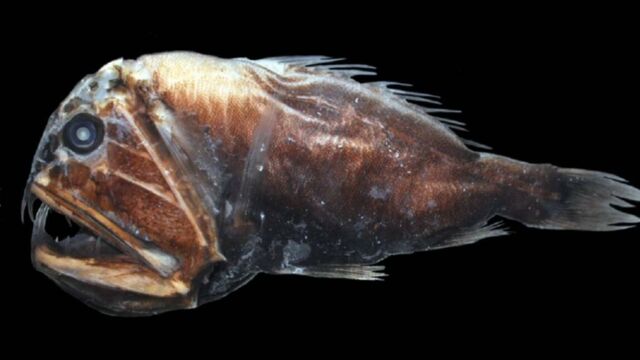The abyss fascinates human. It's the one area of the Earth which we still know very little about. Hostile to surface because of their icy waters, their non-existent light, and their body-flattening pressure, these underwater depths are nevertheless full of species endowed with an unparalleled ability to adapt.
Discover our latest podcast
Among those that have been identified, many have large eyes to compensate for the lack of light, large teeth to capture their prey, and a peculiar type of scale called 'ultra-black.' Absorbing on average 99.5% of the perceived light, the ultra-black scale does not reflect any light and makes the fish almost invisible.
Johnson's abyssal anglerfish

Johnson's abyssal anglerfish, also known as melanocetus johnsonii, is probably the most famous deep-sea fish, and without any doubt the most terrifying. Do you remember the horrible lantern fish in Finding Nemo? That's him. With a head twice as big as its body, it is one of the blackest animals in the world. Belonging to the Melanocetidae family, the Johnson's monkfish is rather widespread, since it can be found in the Atlantic, Pacific and Indian oceans, at a depth of 2,000 m.
While the males measure on average 3 cm, the females can measure up to 20 cm. Because the females are the real predators. And they are the ones who have this famous bioluminescent organ. Perched at the end of a long spine located at the tip of their nose, it is used as a lure to attract prey towards their mouth, only to be gobbled up in a single mouthful. A mouthful during which their long sharp teeth can fold in.
And what of the male, in all that? He lives, quite literally, as a hanger-on to the female, since he attaches himself to her body, feeding on her blood. He then disappears by merging with her, leaving behind only his gonads, thus allowing the female to reproduce.
The black dragonfish

In a completely different style, the black dragon fish, known as Idiacanthus antrostomus, lives more than 1,000 m deep and has a long, snake-like body. Also endowed with ultra-black scales, it reflects less than 0.05% of the light!
Just like Johnson's abyssal anglerfish, the black dragonfish is able to produce its own light, notably thanks to the luminous spots it has along its barbels. A light that allows it, once again, to attract its preys, when it undulates to go back to the surface in order to hunt.
It has a large mouth and particularly penetrating transparent teeth, which allows this fish of the abyss to seize preys as big as him. In terms of measurements, it is once again the females that are the most imposing. They can measure up to 40 cm, while the males measure only about 10 cm.
Fangtooth

Another deep-sea fish with a monstrous physique: fangtooths, known as Anoplogaster cornuta. It owes this unique name to the size of its teeth. And for good reason! It has the largest teeth in the world, in proportion to its size. So much so that it is impossible for it to close its jaw entirely.
But the fangtooth itself is not so big. While, like many abyssal fishes, it has a head much larger than the rest of its body (dark brown to black), on average it measures only 16 cm.
Being able to live up to 5,000 m deep, the fangtooth is a strong predator. A fish-eater, it feeds on everything that crosses its path, as food is scarce at such depths.














